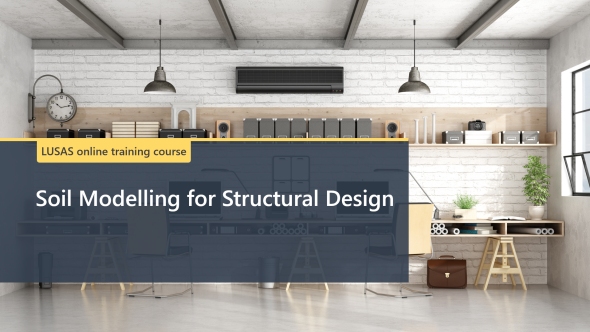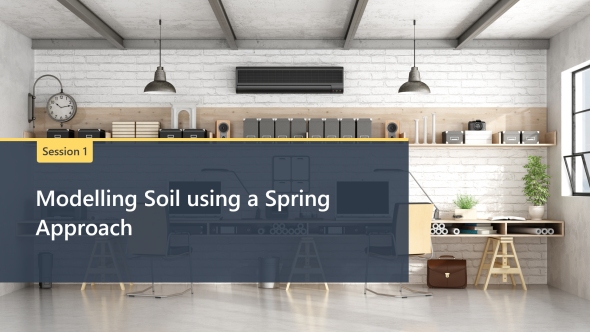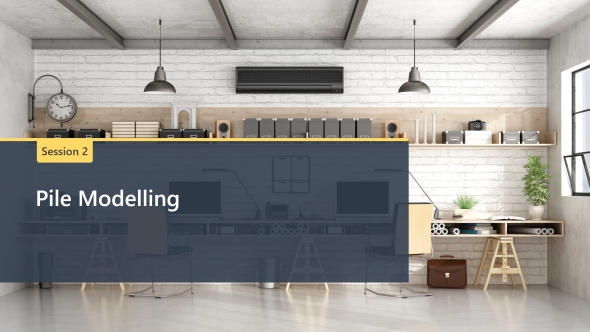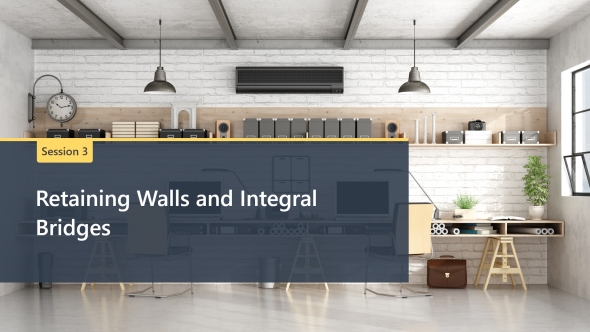Course Summary
|
This course is designed for civil
engineers interested in learning how to model soil interacting with
structures using the Winkler approach.
It is recommended that attendees
have a good understanding of the basic functions of LUSAS; however,
a brief introduction to LUSAS will be provided during the first
session.
The course consists of three live
online sessions, each lasting between 90 to 120 minutes.
The course covers the following
topics:
- How to model soil using a
spring/Winkler approach.
- Modelling supports and
joints.
- Shallow foundations, pile
modelling, volume-beam approach, spring-beam approach, and P-Y
curves
- Retaining walls and integral
bridges.
|
|

|
|
Learn how to:
- Build a model in LUSAS.
- Use various types of supports in
LUSAS, including fixed, lift-off, and contact supports.
- Incorporate joints into models;
diverse joint models, both linear and nonlinear, will be
explained.
- Apply volume-beam, spring-beam
approaches, and P-Y curves.
- Use the Trilinear Earth Pressure
joint to account for soil pressure.
- Model integral bridges using both
continuum and spring approaches.
See typical
course content for each session.
|
Course Session Dates
| Course
name |
Session
dates |
No
of sessions |
Time
of each session |
Course
cost |
Booking |
| Soil
Modelling for Structural Design |
5,
12, 19 March 2026 |
3 |
14:00
- 16:00 GMT |
400
GBP |
 |
Bookings and payments
-
To book and pay for a single place on
a course click the 'Book now' button. If multiple bookings of
staff from the same organisation are required with payment to be
made via a single invoice, please
contact the training course administrator at training@lusas.com
-
Course costs include
handouts and are quoted in local
currencies and are exclusive of any local government taxes (if
applicable).
-
Please note that when paying by credit card the
amount charged in your currency may differ according to exchange rates and credit
card fees incurred, which are beyond our control.
-
For cancellations to attend a training course that are received in writing
at least 1 day prior to the first session taking place, the
course cost will be refunded.
-
LUSAS reserves the right
to reject bookings and
to cancel or re-schedule courses or individual sessions in the
unlikely event of this being required.
A discount is available for an
invoiced booking of 5 or more delegates from the same organisation.
Please contact your account manager or training@lusas.com
for details.
Online training information
| Sessions
presented using |
Session
length |
After
session offline self-study required |
Training
certificates |
| GoToWebinar |
90 to 120 minutes |
45
to 60 minutes |
Issued
on successful completion |
Notes
-
Training sessions
are provided using the GoToWebinar
web conferencing facility. You can join each training session up to 10 minutes before the scheduled start
time. They will start promptly.
-
Training sessions
are a mix of PowerPoint presentation and live demonstration
of LUSAS.
-
Delegates do
not undertake any hands-on examples during each session, but examples that cover the concepts introduced are provided for download and use by
delegates after each session. These examples will take between 45 and 60
minutes of offline self-study to complete. Email support is available from the
presenter to assist with these examples if needed.
-
Session
presentations can be downloaded from a training course event page
and printed off if required.
-
Delegates
are able to ask the presenter
questions during the training session via the chat tool or afterwards via email.
-
Sessions
are recorded and links to recordings will be provided to
delegates to allow viewing if a session is missed.
-
Training
certificates are provided to those who successfully complete the
series of worked examples and pass the quiz set after each
session.
-
Registration
for Session 1 is a requirement to attend all
subsequent sessions.
On successful completion
of the course, and with subsequent experience, delegates should be
able to successfully tackle many types of soil-structure
interaction.
LUSAS software version
Accessing LUSAS
Please note that the
latest release version of LUSAS will be used for the training
course. Individuals who wish to attend the
training who do not have access to the required version of the
software may request a
temporary training licence from LUSAS to allow the running of the
software on their personal computers. After
booking your place on the course, please
contact training@lusas.com
to request a licence stating your name and details as asked for on
the booking form.
Downloading LUSAS
LUSAS may be downloaded either as an
ISO file, or as a small startup executable. Use whichever is better or works for
you.
| Options
for downloading LUSAS Version 23
|
| ISO file
|
OR |
Web
installer
|
| Download a
single disk image file containing all installation
components.
Select this option for offline installation on one or more
PCs. |
Download a
small setup executable which allows you to choose those
components that you wish to download and install.
Select this option for online installation on a single PC.
|
|

|

|
Please contact training@lusas.com
if you have any questions relating to the licence key sent to you.
Typical Course Content
Session 1 - Modelling
Soil using a Spring Approach
 Overview
of LUSAS and basic skills in model building and results processing. Building a
model in LUSAS and using fixed, lift-off, and contact supports. Overview
of LUSAS and basic skills in model building and results processing. Building a
model in LUSAS and using fixed, lift-off, and contact supports.
-
Brief introduction to LUSAS and
its range of applications
-
Soil modelling approaches
available: geotechnical, structural (using spring / Winkler models) and full
soil-structure interaction.
-
Support types, joints and their
application.
-
Presentation example: Strap
footing, Tunnel.
-
Homework example to
be completed by delegates (same as presentation example)
-
Online quiz to complete the
session.
|
Session 2 - Pile
Modelling
 An
overview of different approaches to modelling piles. Incorporate joints into
models; diverse joint models, both linear and nonlinear will be explained. Apply
volume-beam, spring-beam approaches, and P-Y curves. An
overview of different approaches to modelling piles. Incorporate joints into
models; diverse joint models, both linear and nonlinear will be explained. Apply
volume-beam, spring-beam approaches, and P-Y curves.
-
Volume beam approach - meshing,
geometry, material, loading and results.
-
P-y curve approach and
applications.
-
Springs - beam approach, joint
models and applications.
-
Presentation examples: Bridge
pier, Transmission tower.
-
Homework example to
be completed by delegates (same as presentation example)
-
Online quiz to complete the
session.
|
 Session 3 –
Retaining Walls and Integral Bridges Session 3 –
Retaining Walls and Integral Bridges
Using the Trilinear Earth Pressure joint to
account for soil pressure, modelling of integral bridges using both continuum and
spring approaches.
-
Retaining wall modelling: soil
pressure, the trilinear earth pressure joint and its application.
-
Integral bridge analysis
methods: Limiting equilibrium and spring / Winkler approaches;
soil-structure interaction.
-
Presentation examples: Retaining
wall, Integral bridge.
-
Homework example to
be completed by delegates (same as presentation example).
-
Online quiz to complete the
session.
|
|